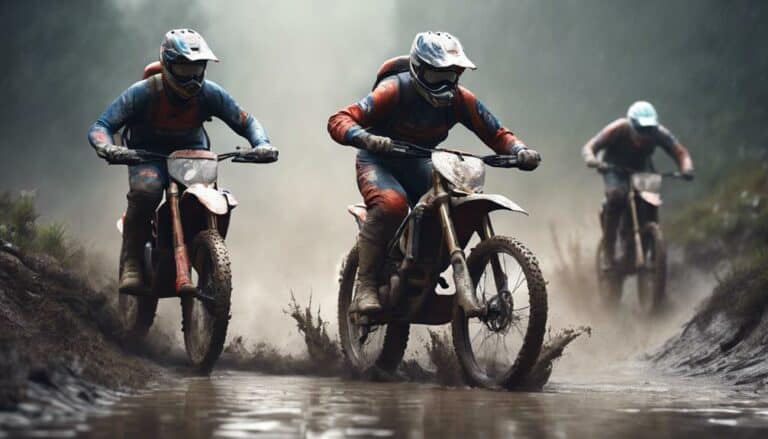Do you ever wonder how weather conditions can impact your enduro racing strategy?
From muddy tracks to slick roots and unpredictable rain, the elements can drastically alter the dynamics of your race.
Understanding how to adjust your approach based on the weather can be the key to gaining a competitive edge and mastering the challenges of enduro racing.
So, are you ready to explore the intricate relationship between weather conditions and strategic decision-making in the exhilarating world of enduro racing?
Key Takeaways
- Proper tire selection like Maxxis Shorty enhances traction and control in wet conditions.
- Adjust speed, weight distribution, and braking technique for improved performance in rainy weather.
- Anticipate terrain changes, maintain a loose stance, and adjust body position for better grip on slick surfaces.
- Adapt riding techniques to ensure stability, traction, and control in extreme weather conditions.
Weather's Impact on Tire Choice
In wet weather conditions, selecting the appropriate tires, such as the Maxxis Shorty with specialized tread patterns, is critical for optimizing traction and performance in enduro racing. When facing slippery and muddy trails, tire selection becomes a pivotal factor that can greatly influence your riding experience. The Maxxis Shorty, designed specifically for such adverse conditions, offers superior traction due to its unique tread pattern that bites into the terrain, providing you with the grip needed to navigate challenging courses with confidence.
Tire selection tailored to weather conditions isn't just about safety but also about enhancing your overall performance. Brands like Maxxis understand the importance of offering options that cater to different terrains, ensuring that riders have the best possible equipment for any situation. By choosing tires like the Maxxis Shorty that excel in wet conditions, you gain a competitive edge by maintaining control and stability throughout the race. Investing time in selecting the right tires based on weather conditions can make a substantial difference in your enduro racing endeavors.
Adjusting Speed for Wet Conditions
Handling wet conditions in enduro racing requires skillful adjustment of speed to guarantee control and traction on slippery surfaces. When maneuvering technical sections in the rain, consider these essential factors:
- Body Position: Shift your weight back slightly to increase rear wheel traction and prevent the front wheel from washing out on wet corners.
- Technical Sections: Approach obstacles cautiously, reducing speed to maintain balance and control over roots and rocks that become more treacherous when wet.
- Power Output: Be gentle with acceleration to avoid wheel spin on slick surfaces, controlling your bike's power delivery to prevent loss of traction.
Handling Mud and Slippery Surfaces
Traversing mud and slippery surfaces demands riders to uphold a loose stance, soft arms, and a relaxed posture to effectively absorb bumps and sustain control during an enduro race. In mountain biking, wet conditions pose a major challenge, requiring riders to adapt their techniques for best performance.
By looking ahead and staying relaxed, riders can navigate muddy trails more effectively, anticipating changes in terrain and maintaining control over their bikes. Proper tire selection, such as utilizing treads like the Maxxis Shorty, can greatly enhance grip on slippery surfaces, important for maintaining traction in adverse weather.
Braking strategies become essential in these conditions, with riders needing to plan braking spots carefully and release brakes strategically over technical sections to improve traction. To keep momentum on wet trails, maintaining a low body position, keeping eyes up, and adjusting weight distribution for slick areas are key techniques that riders can employ to handle mud and slippery surfaces successfully during an enduro race.
Strategies for Riding in Rain
When riding in rainy conditions during an enduro race, adjusting your technique to guarantee peak traction and control becomes paramount. In wet weather, your approach should focus on maximizing grip and stability to traverse the challenging terrain effectively.
Here are some strategies for riding in the rain:
- Low Body Position: Keeping a low body position helps lower your center of gravity, enhancing stability and balance on slippery surfaces.
- Weight Distribution: Effectively distributing your weight on the bike allows for better traction and control, especially when cornering and traversing obstacles.
- Proper Braking Technique: Implementing a precise braking strategy is essential in wet weather conditions. Plan your braking points carefully to avoid skidding and maintain control over your bike.
Adapting to Extreme Weather
Adapting to extreme weather conditions during enduro races necessitates a keen understanding of how environmental factors can impact rider performance and safety. When facing heavy rain or snow, visibility and trail conditions become challenging, requiring adjustments in speed and technique.
In wet conditions, mud and slippery surfaces demand a focus on balance, traction, and control for both climbs and descents. Hot and dry weather can create dusty trails, affecting tire grip and visibility, prompting riders to maintain distance for safety and breathing comfort.
Conversely, cold temperatures in winter races can impact bike performance and rider comfort, necessitating proper clothing layers and hydration strategies to prevent hypothermia. Variable weather conditions during a race test a rider's adaptability and decision-making skills, highlighting the significance of monitoring weather forecasts and adjusting race strategies on the go.
To excel in the ever-changing environment of enduro racing, riders must be prepared to adapt their skills and strategies to whatever extreme weather conditions may arise.
Conclusion
To sum up, the intricate dance between weather conditions and enduro racing strategy is a delicate balance of skill and adaptability.
The ability to navigate through mud and slippery surfaces while maintaining speed and control is a true test of a rider's expertise.
By understanding the impact of weather on tire choice, adjusting speed for wet conditions, and honing techniques for extreme weather, riders can conquer any challenge nature throws their way.
Flexibility and preparation are key to mastering the art of enduro racing in all conditions.

